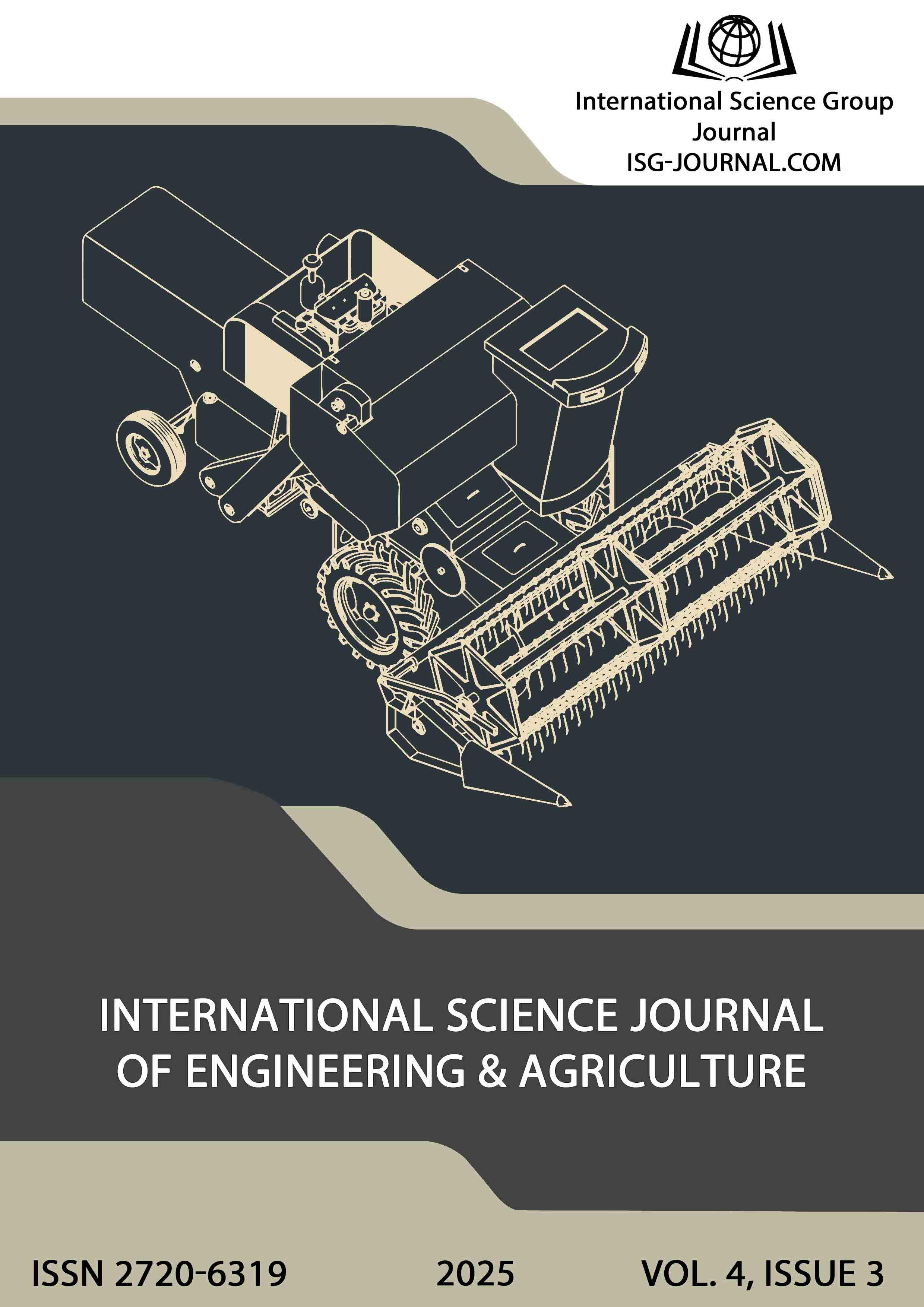Environmentally friendly corrosion inhibitors: a modern alternative to traditional methods of protecting metal structures
DOI:
https://doi.org/10.46299/j.isjea.20250403.06Keywords:
green corrosion inhibitor, metal protection, environmentally friendly technologies, plant extracts, inhibitors based on natural substances, biodegradability, environmental chemistry; phytochemical compounds, electrochemical corrosion, NS4 model environment, Phosphate coatingsAbstract
Metal corrosion is a serious technical and environmental problem that leads to significant economic losses and threatens the safety of infrastructure. Traditional methods of protecting metal structures are based on the use of chemical inhibitors, which are often toxic, poorly biodegradable and hazardous to human health and the environment. In response to these challenges, there is a growing interest in the development of “green” corrosion inhibitors - non-toxic, biodegradable and environmentally friendly substances derived from natural sources. This study examines the effectiveness of aqueous, alcoholic and water-alcohol plant extracts as an alternative to traditional corrosion inhibitors for the protection of 17GS steel in the NS4 model environment. Experimental studies have shown that the water-alcohol extract of Echinacea provides up to 69% protection of steel, the water extract of tea - up to 50%, while the effectiveness of eucalyptus oil was only 12%. The results obtained indicate a significant dependence of the protection efficiency on the type of plant material, extract concentration, exposure temperature, and duration of contact with the environment. Gravimetric analysis confirmed the formation of a dense protective adsorption-oligomeric film on the metal surface, which significantly reduces the corrosion rate and increases the polarization resistance of steel to 15 kΩ at a concentration of 40 ml/l. Microstructural analysis shows that the most effective compounds are those with aromatic structures and nitrogen-containing heterocycles that are able to form stable chemical bonds with the metal surface. A multivariate regression analysis of the dependence of steel corrosion resistance on exposure time, inhibitor concentration, and temperature was performed, which confirmed the significant impact of these factors on metal protection. The studies indicate that it is possible to optimize the composition of inhibitors by using combined herbal preparations and nanostructured additives to increase the duration and effectiveness of the protective effect. The results of this work open up new prospects for the development of environmentally friendly metal protection technologies that meet the concept of sustainable development and the principles of green chemistry. Further research should be focused on finding new sources of bioactive compounds, improving extraction methods, and in-depth study of the mechanisms of protective coatings formation.References
Abd El Rehim, S. S., Ibrahim, M. A. M., & Khalid, K. F. (2011). Natural products as corrosion inhibitors for metals in acidic media. Journal of Materials Science, 46(18), 5052–5061. https://doi.org/10.1007/s10853-011-5435-z
Raja, P. B., & Sethuraman, M. G. (2008). Natural products as corrosion inhibitor for metals in corrosive media – A review. Materials Letters, 62(1), 113–116. https://doi.org/10.1016/j.matlet.2007.04.079
Verma, C., Ebenso, E. E., Quraishi, M. A., & Obot, I. B. (2016). Green corrosion inhibitors for sustainable protection of metals in corrosive media: An overview. International Journal of Environmental Science and Technology, 13, 391–404. https://doi.org/10.1007/s13762-015-0884-2
Singh, A., Ahamad, I., & Quraishi, M. A. (2010). Ginger extract as green inhibitor for mild steel in hydrochloric acid. Journal of Materials and Environmental Science, 1(2), 101–110.
Umoren, S. A., Obot, I. B., & Ebenso, E. E. (2008). The synergistic inhibition effect of polyethylene glycol and halide ions on the corrosion of mild steel in H2SO4. Chemical Engineering Communications, 195(13), 1575–1583. https://doi.org/10.1080/00986440802031058
Oguzie, E. E. (2007). Corrosion inhibition of mild steel in hydrochloric acid using Telfaria occidentalis extract. Corrosion Science, 49(7), 1527–1539. https://doi.org/10.1016/j.corsci.2006.08.007
Prabakaran, M., & Ramesh, S. (2011). Synergistic corrosion inhibition effect of sodium dodecyl benzene sulfonate and Zn2+ ion system in neutral aqueous environment. Arabian Journal of Chemistry, 4(3), 343–350.
Popova, A., Christov, M., & Vasilev, A. (2007). Inhibitive properties of quaternary ammonium bromides of N,N-dimethylaminoethanol in acid mild steel corrosion. Corrosion Science, 49(8), 3290–3302. https://doi.org/10.1016/j.corsci.2007.03.005
Abdallah, M. (2004). Guar gum as corrosion inhibitor for carbon steel in sulfuric acid solutions. Portugaliae Electrochimica Acta, 22(2), 161–175.
Solomon, M. M., Umoren, S. A., & Udosoro, I. I. (2010). Inhibitive and adsorption behavior of carboxymethyl cellulose on mild steel corrosion in hydrochloric acid solution. Corrosion Science, 52(4), 1317–1325. https://doi.org/10.1016/j.corsci.2009.11.027
Rosliza, R., & Wan Nik, W. B. (2010). The corrosion inhibition of mild steel in 1 M hydrochloric acid solution by Eurycoma longifolia extract. Materials Chemistry and Physics, 125(3), 798–804. https://doi.org/10.1016/j.matchemphys.2010.09.004
Polutrenko, M., Fedorovich, Y., Hrytsulyak, H., & Kotsyubynsky, A. (2022). Influence of composition of soil electrolyte model environments on corrosion rate of tube steel. Ecological Engineering and Environmental Technology, 23(5), 20–24. https://doi.org/10.12912/27197050/150173
Poberezhny, L., Stanetsky, A., Grytsuliak, G., Kosmii, M., & Hrytsanchuk, A. (2019). Corrosion-mechanical behavior of gas main steel in saline soils. Koroze a Ochrana Materialu, 63(3), 105–112. https://doi.org/10.2478/kom-2019-0017
Rani, B. E. A., & Basu, B. B. J. (2012). Green inhibitors for corrosion protection of metals and alloys: An overview. International Journal of Corrosion, 2012, 1–15. https://doi.org/10.1155/2012/380217
Quraishi, M. A., & Ansari, F. A. (2003). Corrosion inhibition by fatty acid surfactants: Review. Anti-Corrosion Methods and Materials, 50(6), 414–419. https://doi.org/10.1108/00035590310503441
Downloads
Published
How to Cite
Issue
Section
License
Copyright (c) 2025 Tetyana Kalyn, Olga Fomicheva, Halyna Hrytsuliak, Yury Voloshyn, Tetiana Hoisan

This work is licensed under a Creative Commons Attribution 4.0 International License.






